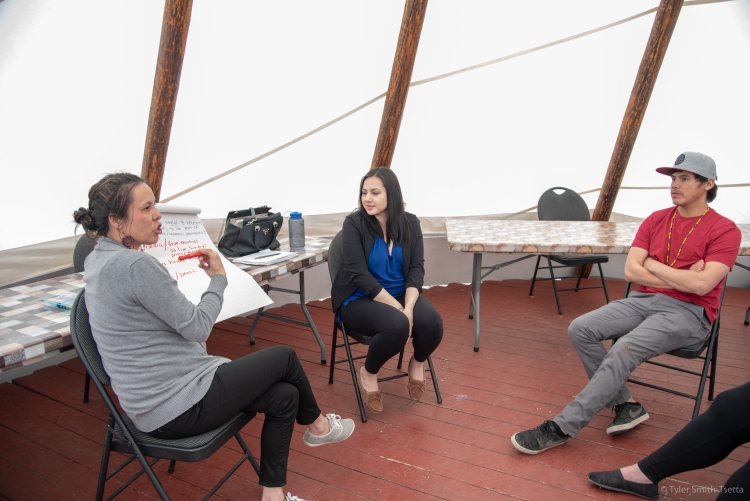
Hotıì ts'eeda summer students Joni Tsatchia and Roxanne Kotchilea lead a youth engagement focus group.


Hotıì ts'eeda summer students Joni Tsatchia and Roxanne Kotchilea lead a youth engagement focus group.
Listening to the voices of youth is an important value to Indigenous communities. Youth engagement is linked to positive outcomes for young people, adults, agencies, and communities. Research projects that can integrate youth successfully in planning and making decisions are likely to be more effective and produce better research findings. Hotıì ts’eeda’s summer students engaged in a field research project in the summer of 2018 to ask youth the best ways to engage them. They developed some key findings that can help health researchers and others involved in the health system better connect with youth.
Youth are critical thinkers, and recognize when their participation is tokenistic. To truly engage youth, their thoughts and opinions need to be valued: they need to have decision-making power over aspects of the research project that affect them. Indigenous youth told us that Indigenous people should be in leadership positions, especially youth. For example, they suggest that positions such as a youth advisor, advisory board or council representative on a health project would make the project more effective in engaging youth and incorporating their views.
Authentic relationships require research projects to be transparent: to share information about the purpose and thinking behind a research project. By sharing and including the community in this process, researchers can build trust with the community and also ensure the foundations of their research projects are strong and not built on assumptions of what would benefit the community.
We found that informal, in-person discussion isthe best way to engage deeply with Tłı̨chǫ youth. It was important to youth that they be allowed to slowly warm up to the deeper, more challenging questions, after informal discussion and getting to know the group. We recommend talking circles, accompanied by in-person interviews, as a key method in engaging and sharing knowledge with youth research participants.
Youth suggested that to engage larger numbers of youth, attaching events to existing in-person gatherings such as Youth Summits or community gatherings could be effective. They also suggested that research projects could hold open houses (with incentives such as snacks and prizes) to attract youth and share information about research projects.
Land-based and traditional gatherings and activities were recommended as a good environment in which to discuss health subjects. Youth respond well to programs that incorporate being out on the land and engaging in traditional activities while learning about health. FOXY and SMASH were brought up as examples of successful implementation research projects that incorporated traditional activities.
Integrating research projects into schools and existing youth-focused activities and programs in communities is an effective way to engage youth. Adding additional responsibilities and activities to a youth’s extracurricular life can be more challenging, while incorporating activities into a class or even lunchtimes can increase success. Youth suggested researchers could go into schools as guest speakers to introduce their projects and motivate youth to participate in research projects.
Social media is a crucial tool to raise awareness and engage youth. Youth do not want to receive emails or paper brochures about a project or program, and it is unlikely that they will read the content beyond the headline. Social media such as Facebook and Instagram are effective in engaging youth especially through online surveys and contests, both for data collection and knowledge sharing. Youth are already spending a great deal of their time on social media—integrating health content and questions into their pages is a way to meet youth where they’re at.
Incentives are a great way to encourage youth to participate in research projects. Class credit, honoraria, prizes or something as simple as having snacks available at an activity work to incentivize youth to attend and engage with research, and demonstrate that their participation is valued.
NWT communities and Indigenous groups are very diverse. No one solution can be guaranteed to work across all youth or all communities. While our research reflects what we heard from youth across the Tłı̨chǫ region, other regions may be better engaged in different ways.
---
Contact Hotıì ts’eeda for information, advice and support in engaging youth in NWT communities.